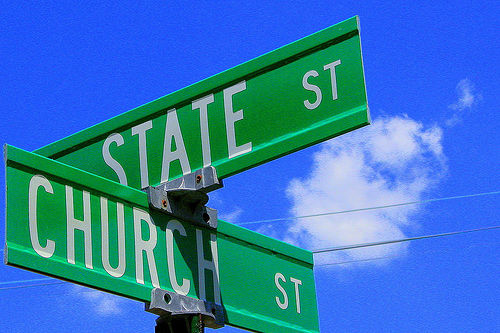"Are the Church and the State Substitutes?: Evidence from the 1996 Welfare Reform".
The author Daniel Hungerman is one of my economic heroes and his other work was an inspiration to me when starting graduate coursework in economics. At that time (and still) one of my chief interests was taking care of the poor and how voluntary associations attempted to tackle problems of poverty. This paper starts from the basic premise that the Church and State are both interested in charitable spending. For example, churches provide food pantries and soup kitchens to the poor and the government provides food stamps. But, how is their spending towards these goods related?
There is a literature in public economics on crowding out. Crowding out is said to occur when an increase in public expenditures towards some good/service (for example food stamps) reduces the amount private organizations like churches or nonprofits spend on that same good/service (food pantries).
The 1996 Welfare Reform Act represented a landmark piece of legislation that curtailed spending on Aid to Families with Dependent Children, Supplemental Security Income, Food Stamps, and Medicaid. Because we think the church and state might be substitutes we want to know how this legislation impacted church spending. The chief problem in comprehending this question was that there was no variation. Since the welfare law impacted all communities at the same time we would need reason to believe it impacted some communities at different magnitudes.
Hungerman came up with a brilliant strategy to measure the magnitude: Because the welfare laws impacted immigrants in a different manner than the welfare population at large and because different communities had different immigrant populations we should see the church respond with more vigorous charitable work in areas with larger immigrant populations (if in fact the church and state are substitutes).
In fact, the churches do respond more in communities with larger immigrant populations. Moreover, this response is not trivial. For each dollar reduction in government spending the church increased spending of 40 cents. This becomes an even bigger question if we start to wonder who is the more efficient provider of public services.
I will close with one final interesting but dampened note on this research. While the Welfare Reform Act had an impact on church spending it *did not* have an impact on donations. This seems to suggest that during this time churches were dipping into extra funds. In the short run this might be fine; however, if this were a sustainable form of charitable action donations would need to pick up in the long run.
In fact, the churches do respond more in communities with larger immigrant populations. Moreover, this response is not trivial. For each dollar reduction in government spending the church increased spending of 40 cents. This becomes an even bigger question if we start to wonder who is the more efficient provider of public services.
I will close with one final interesting but dampened note on this research. While the Welfare Reform Act had an impact on church spending it *did not* have an impact on donations. This seems to suggest that during this time churches were dipping into extra funds. In the short run this might be fine; however, if this were a sustainable form of charitable action donations would need to pick up in the long run.


No comments:
Post a Comment